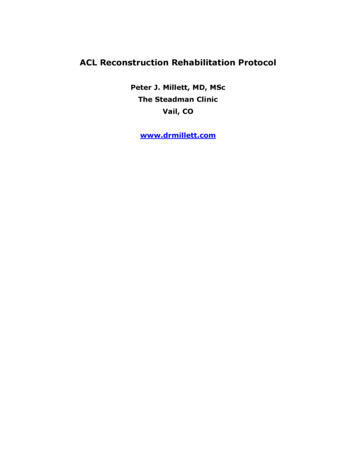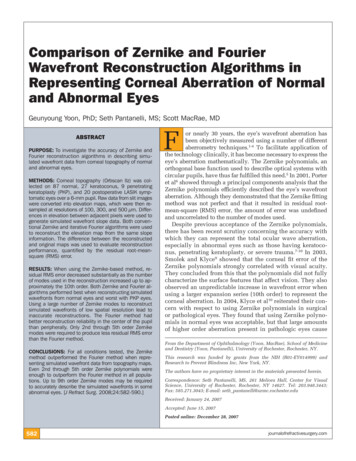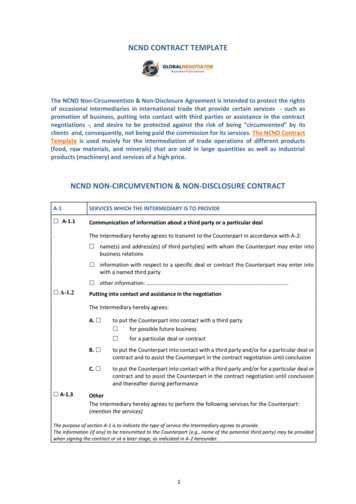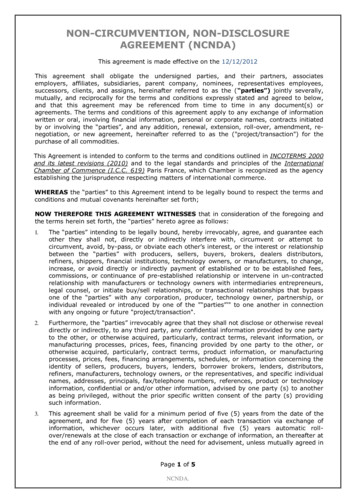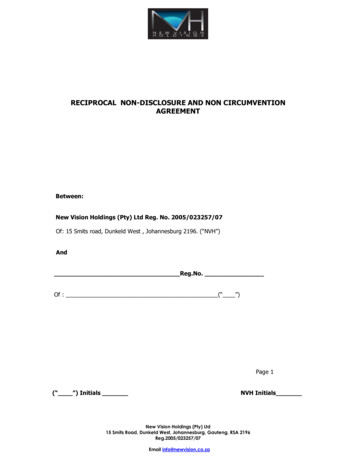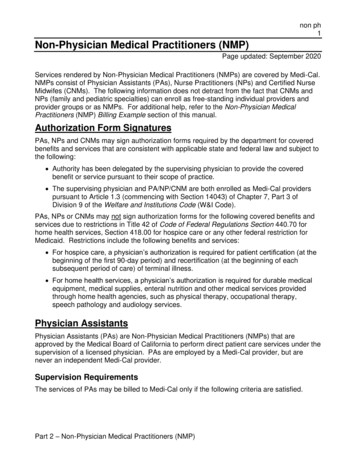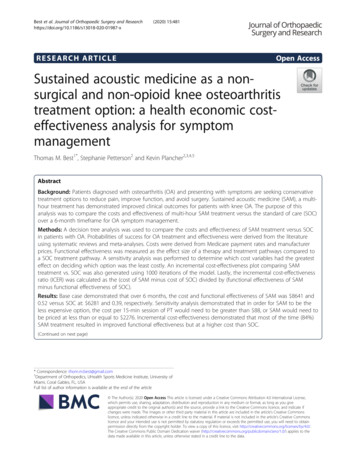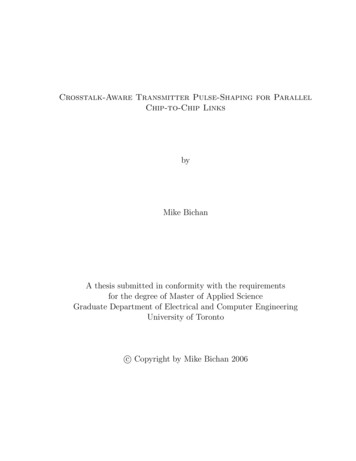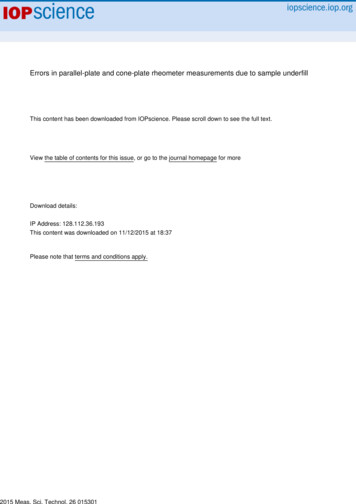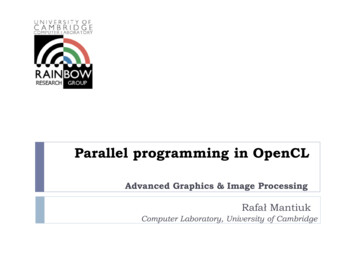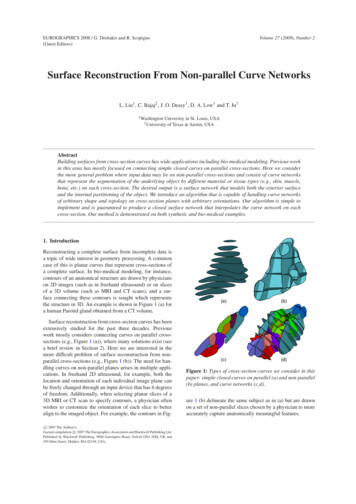
Transcription
EUROGRAPHICS 2008 / G. Drettakis and R. Scopigno(Guest Editors)Volume 27 (2008), Number 2Surface Reconstruction From Non-parallel Curve NetworksL. Liu1 , C. Bajaj2 , J. O. Deasy1 , D. A. Low1 and T. Ju11 WashingtonUniversity in St. Louis, USAof Texas at Austin, USA2 UniversityAbstractBuilding surfaces from cross-section curves has wide applications including bio-medical modeling. Previous workin this area has mostly focused on connecting simple closed curves on parallel cross-sections. Here we considerthe more general problem where input data may lie on non-parallel cross-sections and consist of curve networksthat represent the segmentation of the underlying object by different material or tissue types (e.g., skin, muscle,bone, etc.) on each cross-section. The desired output is a surface network that models both the exterior surfaceand the internal partitioning of the object. We introduce an algorithm that is capable of handling curve networksof arbitrary shape and topology on cross-section planes with arbitrary orientations. Our algorithm is simple toimplement and is guaranteed to produce a closed surface network that interpolates the curve network on eachcross-section. Our method is demonstrated on both synthetic and bio-medical examples.1. IntroductionReconstructing a complete surface from incomplete data isa topic of wide interest in geometry processing. A commoncase of this is planar curves that represent cross-sections ofa complete surface. In bio-medical modeling, for instance,contours of an anatomical structure are drawn by physicianson 2D images (such as in freehand ultrasound) or on slicesof a 3D volume (such as MRI and CT scans), and a surface connecting these contours is sought which representsthe structure in 3D. An example is shown in Figure 1 (a) fora human Parotid gland obtained from a CT volume.Surface reconstruction from cross-section curves has beenextensively studied for the past three decades. Previouswork mostly considers connecting curves on parallel crosssections (e.g., Figure 1 (a)), where many solutions exist (seea brief review in Section 2). Here we are interested in themore difficult problem of surface reconstruction from nonparallel cross-sections (e.g., Figure 1 (b)). The need for handling curves on non-parallel planes arises in multiple applications. In freehand 2D ultrasound, for example, both thelocation and orientation of each individual image plane canbe freely changed through an input device that has 6 degreesof freedom. Additionally, when selecting planar slices of a3D MRI or CT scan to specify contours, a physician oftenwishes to customize the orientation of each slice to betteralign to the imaged object. For example, the contours in Figc 2007 The Author(s)Journal compilation c 2007 The Eurographics Association and Blackwell Publishing Ltd.Published by Blackwell Publishing, 9600 Garsington Road, Oxford OX4 2DQ, UK and350 Main Street, Malden, MA 02148, USA.Figure 1: Types of cross-section curves we consider in thispaper: simple closed curves on parallel (a) and non-parallel(b) planes, and curve networks (c,d).ure 1 (b) delineate the same subject as in (a) but are drawnon a set of non-parallel slices chosen by a physician to moreaccurately capture anatomically meaningful features.
L. Liu et. al. / Surface Reconstruction From Non-parallel Curve NetworksFigure 2: Surface reconstruction from curve networks: the input with 3 region labels: blue, red and white (a), surfaces independently constructed from simple closed curves bounding the blue or red regions (b) resulting in a non-closed partitioning ofspace as seen in the cut-away view (c), and a closed surface network generated by our method (d) with a cut-away view (e).Another demand that increasingly arises in engineeringand medical applications is reconstructing objects that aresegmented by different material or tissue types. This leadsto curve networks that partition each cross-section plane intoregions associated with multiple labels (e.g., air, muscle,bone, etc.). Figure 1 (c) shows an example curve networkthat represents the segmentation of the mouse brain into various anatomical structures on a single cross-section, and Figure 1 (d) shows a set of these cross-sections from which asurface representing the segmented mouse brain needs to bereconstructed. In particular, we desire the reconstruction tobe a surface network that partitions the space into labelled3D regions. Note that the simple closed curves in Figure 1(a,b) are also a curve network where the regions labels aresimply inside and outside.1.1. Problem statementWe consider the general problem of surface reconstructionfrom curve networks on possibly non-parallel cross-sections.Specifically, given a set of planes partitioned by curve networks into labelled 2D regions, we desire a surface networkwith the following properties: Closed: The surface network partitions the space into labelled 3D regions, so that two regions sharing commonboundary have different labels (e.g., inside and outside). Interpolating: The surface network interpolates the curvenetworks, and the labels of partitioned 3D regions are consistent with those of 2D regions on each cross-section.To the best of our knowledge, the reconstruction problemhas never been tackled at this level of generality. While afew methods were proposed for handling non-parallel crosssections, including the very recent work of Boissonnat andMemari [BM07], these methods are restricted to simpleclosed curves on each cross-section. To handle multiplylabelled curve networks, one may apply these methods to reconstruct one surface for each label, by considering only thesimple closed curves bounding regions of that label on eachcross-section, and combine these surfaces together. However, the resulting surface may easily violate the closednesscriteria, as illustrated in Figure 2: while surfaces can be constructed each for the blue and red label of the input curvenetworks (a), their combination in (b) inevitably leads to anon-closed surface as a portion of surface (pointed by the arrow in (c)) is shared by two 3D regions of a same label (red).Similar observations were made by Weinstein [Wei00] andJu et al. [JWC 05], who proposed different methods capable of generating closed surface networks from inputs containing curve networks. However, both of these methods arerestricted to parallel cross-sections.1.2. Method overviewWe present a novel algorithm for surface reconstructionfrom non-parallel curve networks. We follow the divide-andconquer strategy of Boissonnat and Memari [BM07] andconsider the partitioning of space into cells by all crosssection planes (known as an arrangement). The core ofour algorithm is the construction of a closed surface network within each partitioned cell, which generalizes theprojection-based approach of [JWC 05] from between twoparallel planes to within an arbitrary convex space. Unlike[BM07] or [JWC 05], our algorithm handles both paralleland non-parallel planes as well as curve networks on eachplane.The result of our algorithm, while satisfying the closedness and interpolation criteria, may exhibit a jagged appearance unsuitable for applications where smooth surfaces aredesired. We next utilize existing techniques to improve thesurface quality, in particular, for modelling smooth anatomical structures in bio-medical applications. We consideredmesh fairing based on surface-diffusion flow [SK01, YB02,XPB06] and mesh refinement via edge-swapping and triangle splitting [PS96]. An example result is shown in Figure 2(d,e).Contribution We introduce a simple and robust algorithmthat is guaranteed to produce a closed surface network interpolating arbitrary curve networks on cross-sections witharbitrary (parallel or non-parallel) orientations. The methodis demonstrated on both synthetic and medical examples.c 2007 The Author(s)Journal compilation c 2007 The Eurographics Association and Blackwell Publishing Ltd.
L. Liu et. al. / Surface Reconstruction From Non-parallel Curve Networks2. Previous workWe start by briefly reviewing representative work on surface reconstruction from planar curves (also known as contour interpolation or contour stitching), with an emphasis onthe limitation of these methods in handling complex inputs.Note that a closely related area is the interpolation or approximation of spatial curves with smooth algebraic surfaces[BI92, BIW93] or spline representations [XBE02, BCX95],where the resulting surface is either limited to simple topologies or based on an initial polyhedral surface.2.1. Simple closed curvesParallel cross-sections The majority of surface reconstruction methods are developed for connecting simple closedcurves lying on parallel planes. Early approaches attemptedto find a polygonal tiling that connected curve loops ontwo neighboring planes while optimizing a quality measure [Kep75, FKU77, CS78, MSS92]. Unfortunately, thesetiling methods may fail to generate closed surfaces betweenplanes containing multiple and nested curve loops. Robusthandling of these more complex cases has become the focus of recent work. Among them, Boissonnat [Boi88] pioneered the method based on Delaunay-meshing, which hasbeen refined and improved in later work [Gei93, CD99].The methods of Herman et al. [HZB92] and Csebfalvi etal. [CNKG02] represent the 2D curves on each plane usingimplicit functions and extract the 3D surface by interpolating these functions. The two steps of building and interpolating the implicit functions are combined in the variationalframework of Turk et al. [TO99]. Also, a number of methods[BS96,BCL96,OPC96,KSS00,BGLSS04] have been developed based on computing orthogonal projections of curvesfrom two neighboring planes onto a common plane. For example, the method of Barequet et al. [BGLSS04] obtainsintersections of projections from inside and outside regionson different planes, triangulates the intersected regions using Straight Skeletons [AA96], and lifts the triangulations in3D to form the final surface. In a more recent work [BV07],the authors utilized the projection to find the matching between neighboring planes and constructed the geometry byperforming non-linear interpolation across multiple planes.Non-parallel cross-sections Very few methods have beendeveloped for connecting curves on non-parallel planes. Several attempts have been made [RU90, WMT 95, BTS04] toextend implicit interpolation onto non-parallel planes. Thesemethods are limited to the special case of serial planes sothat the surface can be built from pieces, each of whichbounded between two neighboring planes. More general approaches have been proposed by Payne and Toga [PT94], byDance and Prager [DP97], and very recently by Boissonnatand Memari [BM07], who extended the original Delaunaymeshing method from parallel cross-sections [Boi88]. Acommon strategy adopted in these methods is to considera partitioning of space by all cross-section planes. Withineach partitioned cell, a closed triangular mesh is extractedc 2007 The Author(s)Journal compilation c 2007 The Eurographics Association and Blackwell Publishing Ltd.as the exterior of a 3D tetrahedral mesh connecting the cellboundary. In particular, Boissonnat and Memari [BM07] introduced the branching diagram to characterize the surfacetopology within each cell.2.2. Curve networksWhile many of the above-mentioned methods can handlecurves with arbitrarily complex shape and topology, theyare designed for simple closed curves that bi-partition eachplane into inside and outside regions. Few attempts havebeen made so far to extend these approaches to handle curvenetworks. Weinstein [Wei00] extended implicit interpolationby representing the curve network on each plane as a multilabelled implicit function. More recently, Ju et al. [JWC 05]extended the contour projection approach of [BGLSS04]from simple closed curves to curve networks by considering intersections of projections from regions with differentlabels on different planes. Note that both methods rely heavily on the fact that the curve networks reside on parallelplanes, so that there is a well-defined direction (i.e., the planenormal) for implicit interpolation [Wei00] and for projection [JWC 05].3. The algorithmWe now describe our algorithm for reconstructing a surfacenetwork from non-parallel curve networks. To handle nonparallel cross-sections, we follow the general divide-andconquer strategy adopted in previous works [DP97, BM07].In particular, we consider the partitioning of space into cellsby the set of all cross-section planes (known as the arrangement in Computational Geometry). The complete surfaceis built by first constructing a piece of surface within eachpartitioned cell, followed by stitching together pieces fromneighboring cells. Note that if each surface piece is closedwithin the cell and interpolates the curves on the cell boundary, the result after stitching will remain closed and interpolating.The remaining problem is how to construct a closed surface network within each cell that interpolates the curve networks on the cell boundary. To this end, we generalize theprojection-based approach of [JWC 05] from a cell boundedby two parallel planes to an arbitrary cell bounded by multiple intersecting planes. We will describe the basic ideas in2D before presenting the full algorithm in 3D.3.1. The idea in 2DWe begin by considering a simpler, lower-dimensional problem in 2D. Here the input is a set of cross-section lines, eachdivided by a set of points into labelled 1D regions. Two examples are shown in Figure 3 for two parallel cross-sections(a) and three non-parallel cross-sections (e). In this paper,we assume that the inputs are valid cross-sections, in thatthe region labelling on two intersecting cross-sections areconsistent at their intersection. In this 2D setting, our goal
L. Liu et. al. / Surface Reconstruction From Non-parallel Curve 1678516785B(e)(f)(g)(h)Figure 3: 2D illustration of our algorithm for parallel (top) and non-parallel (bottom) cross-sections (see Section 3.1).is to reconstruct a closed curve network that interpolates thepoints on the cross-section lines.Following the divide-and-conquer strategy, we considerthe partitioning of the plane by all the lines into cells, suchas the shaded regions in Figure 3 (a,e). Note that each cellis necessarily convex. Our task is to construct a closed curvenetwork within each cell that interpolates the points on thecell boundary.A simple algorithm exists [JWC 05] for the case of a cellbounded by two parallel lines, like that in Figure 3 (a). Theidea is to partition the cell into smaller compartments, eachattached to, and labelled by, a 1D region on the cell boundary. Specifically, the cell is first divided into two compartments by the medial line between the two lines (dashed in(b)), then broken into smaller compartments by the segmentsthat connect each point on the cell boundary to its orthogonal projection on the medial line (shown in (c)). The keyobservation is that the curve network separating neighboringcompartments with different labels (e.g., yellow lines in (d))is closed and interpolates the points on the cell boundary.We extend this simple idea to cells bounded by multiplelines. The key modification we make is replacing the medial line between two parallel lines by the more general medial axes (MA) of a cell. The MA is the loci of points thatare closest to two or more points on the cell boundary. Because the cell is convex, the MA consists of a set of lines orline segments (e.g., dashed lines in Figure 3 (b,f)). Note thatthe medial line is a special case of the MA when the cell isbounded by two parallel lines.Using the MA, we can apply the above medial line projection algorithm to an arbitrary cell, which we will illustrate using the example in Figure 3 (e). First, the cell is partitioned into compartments by the MA (dashed in (f)) as wellas the segments that connect each point on a cell boundary to its orthogonal projection on the MA (shown in (g)).Next, the curve network is extracted as the boundaries be-tween neighboring compartments with different labels (e.g.,yellow lines in (h)). As in the original algorithm [JWC 05],this curve network is closed and interpolates the points onthe cell boundary.Why medial axes: Note that the use of orthogonal projection and the MA in the algorithm is not a necessary conditionfor producing a closed curve network. In particular, pickingother projection directions or other shapes to project ontomay yield curve networks with a different topology. One advantage of using the MA and orthogonal projection is thatthe correlation between topology of the resulting curve networks with the configuration of cross-section planes can bemathematically characterized. Formally, let A and B be two1D regions with a common label on different boundary linesof a cell (see Figure 3 (a,e)). By the definition of the MA, Aand B will both belong to the same 2D region partitioned bythe resulting curve network (e.g., the blue regions in Figure3 (d,h)) if there exists a circle inscribing the cell at a point inA and a point in B (see Figure 3 (a,e)).3.2. The algorithm in 3DThe 2D idea can be easily extended to 3D. Our algorithmtakes as its input a set of cross-section planes, each containing a curve network with partitioned 2D regions labelled.The curves are represented as piece-wise linear polylines.The algorithm first computes a partitioning of the space byall planes. Within each partitioned cell bounded by a subset of planes (like that in Figure 4 (a)), the algorithm closelyfollows the 2D approach to build a closed surface networkinterpolating the curve networks on the cell boundary: Step 1: Obtaining MA. Compute the MA of the cell.Since a cell is always convex, the 3D MA consists of planar pieces called sheets (dashed in Figure 4 (a)). Step 2: Forming compartments. The cell is partitionedinto compartments by the MA sheets and polygons connecting the curve networks to their orthogonal projectionsc 2007 The Author(s)Journal compilation c 2007 The Eurographics Association and Blackwell Publishing Ltd.
L. Liu et. al. / Surface Reconstruction From Non-parallel Curve Networksput) around the curve networks and treat each wall of thebounding box as a new cross-section containing no curves.Note that the addition does not affect the closedness or interpolation of the result.(a) Computing MA(b) Projecting curvesComplexity analysis Here we briefly analyze the time complexity of each part of the algorithm. Computing the partitioning of the space by k planes can be done in O(k3 ) timeas in [BM07]. Within each convex cell bounded by n planescontaining m curve-network vertices, computing the MA using [SPB96] takes O(ns n) time where ns is the number ofseams between the MA sheets, while Straight Skeleton triangulation costs O(m2i log(mi )) time for a region on the MAwith mi vertices projected from the cell boundary, amountingto O(m2 log(m)) time for all regions in the worse case.4. Mesh improvement(c) Surface extraction I(d) Surface extraction IIFigure 4: 3D illustration of our algorithm within a cell.on the MA. Note that new vertices may be created whenprojecting the curve networks onto the MA if the projections from different planes intersect with each other orwith the border of a MA sheet (yellow dots in Figure 4(b)). Each compartment is attached to, and labelled by, a2D region on the cell boundary. Step 3: Extracting surfaces. The surface network is extracted as the boundaries between neighboring compartments associated with different labels. Specifically, thisnetwork has two parts: triangulated portions of the MAsheets that are projected from a single region on the cellboundary (e.g., a,b,d in Figure 4 (b)) or from two regionswith different labels (e.g., c in Figure 4 (b)), shown inFigure 4 (c), and triangulated polygons connecting curvenetwork edges to their project
as the exterior of a 3D tetrahedral mesh connecting the cell boundary. In particular, Boissonnat and Memari [BM07] in-troduced the branching diagram to characterize the surface topology within each cell. 2.2. Curve networks While many of the above-mentioned methods can handle

